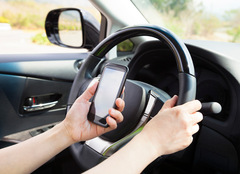
We see it all the time. A car swerving on the road, cutting people off, the driver oblivious to the danger they are causing. Is there something you can do? Yes, drivers should speak up to ensure their safety.
We spoke with Lieutenant J. Paul Vance from the Connecticut State Police for some tips on how you can report an incident before it becomes a tragedy.
If you see someone driving recklessly--whether it be from texting, drunk or drowsy driving, being overly aggressive, or otherwise careless driving--report it by calling 911. But only call if you feel it's a dangerous situation. Remember, the 911 system is intended to render urgent assistance in true emergencies. "911 should not be used for simple motor vehicle violations. The driving behavior must be a danger to the public and place people in harm's way," says Vance.
Learn more about staying safe behind the wheel in our guide to distracted driving.
If you do call 911, pull over and tell them your location, description of the driver and their direction of travel. Don't attempt to follow the car, nor shoot a cell-phone picture, as these actions may magnify the potential roadway dangers. In fact, because you have identified this driver as a threat, be sure to exercise caution and maintain a safe distance from their vehicle.
The license plate number, state of origin, vehicle make, model, and color are also helpful for police to find the offender. Vance notes that by calling 911, you are a witness if a case ever were to come to trial. Before any action can be taken, a witness or police need to observe a violation.
Cell phone use, and in particular texting while driving, has contributed to a national driving-while-distracted epidemic, with over 3,000 people killed and over 387,000 injured each year. Safety experts and government officials caution that the number is likely under reported.
Remember, no text or call is worth a life. Pull over or wait until you are safely at your destination to communicate. If you must stay connected while in motion, use hands-free technologies, such as speaker phone or Bluetooth connectivity, or task a passenger with this duty.
For more on distracted driving, see our special section including our latest driver survey and what is helping to combat the problem.





